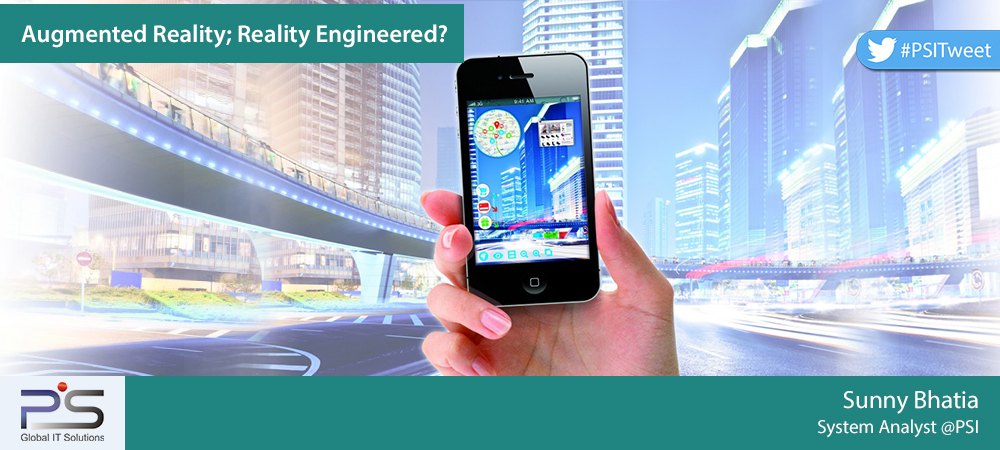Today we see the real world getting replicated electronically in the form of graphics, or visual illustrations. All this is possible with the blend of real scenes viewed with the computer generated data to produce enticing environment. This new technology is termed as Augmented Reality. It enhances the user sensory experience by supplementing the scenes with additional information. In the Augmented Reality environment, user cannot differentiate between the real world and the virtual settings engineered and shown.
It can be done by video streaming and digitally rendering graphics onto that stream or using a transparent display medium and project the virtual elements onto the display. Such elements optically appear to be related to real-world objects.
What does this comprise?
There are many components that make the system perform. They could be display devices, tracking systems and mobile computing power. Inventions like Head Mounted Displays, Spatial Display Devices, and Handheld Display Devices all fall in the display devices category. Getting the right information at the right place and at right time is the key. This requires tracking systems. They can range from digital cameras, optical sensors to GPS, Gyroscope, and compass. The application software, algorithms and processors connect and provide strength to the system.
Application Areas
There are several areas that utilize the power of Augmented Reality:
-
Hotel and Restaurants Information on the Go; we just need to direct the mobile device towards the buildings. Unifying the application software with the device capability will provide the information. It could be about Hotel Ratings, Location, Customer Reviews or Rent Structure. Similar information on the food chains operational inside the building can also be established.
-
Social Identity of Crowd; point the display devices towards the crowd and capture their faces. The required information like their personal identity, social profiles etc, will be displayed on the device.
-
Identifying Unknown Visitors at the Door; door lens embedded with AR can help us in identifying the individual information like- name, age, locality, any criminal record, social profile, status, etc.
-
AR for Sports; widely being employed to improve prevalent coaching methods, help in match analysis and prevent controversial umpiring related decisions.
What it means for Consumers?
-
It has taken the customer apparel shopping experience to the next level. Best example is Microsoft Kinect Virtual Dressing Rooms. Here the customers get chance to virtually try on clothes before actual buying. It is designed and developed for Retail Chain stores and help in increasing the purchase intent.
-
Companies can improve sales by adding Gamification on the physical products; it helps in engaging customers and offering discounts on winning games. Thus, win-win situation for both parties.
-
Using 3D product preview kiosks e.g Lego, customers can observe the product demonstration before jumping onto the buying decision. It presents the user with a 3D view of the product inside the box, thus assisting in how it looks like. In a retail environment, these kinds of kiosks really help the customers to get a better preview.
-
Visual product catalogs; customers can have a real time scalable view of how the product will look and fit at their homes or office space.
Its Future?
Augmented reality technology is dynamic and evolving in nature. It has come a long way but still it has to cover miles. Tracking and analyzing the unprepared environments is still a major challenge. Latency has to be handled in order to deliver the information in real time. Many other factors like dim displays, data redundancy and calibration of devices contribute to the overall potential of the data. This might hamper the viewing experience.
Image Courtesy: www.t-immersion.com
Today we see the real world getting replicated electronically in the form of graphics, or visual illustrations. All this is possible with the blend of real scenes viewed with the computer generated data to produce enticing environment. This new technology is termed as Augmented Reality. It enhances the user sensory experience by supplementing the scenes with additional information. In the Augmented Reality environment, user cannot differentiate between the real world and the virtual settings engineered and shown.
It can be done by video streaming and digitally rendering graphics onto that stream or using a transparent display medium and project the virtual elements onto the display. Such elements optically appear to be related to real-world objects.
What does this comprise?
There are many components that make the system perform. They could be display devices, tracking systems and mobile computing power. Inventions like Head Mounted Displays, Spatial Display Devices, and Handheld Display Devices all fall in the display devices category. Getting the right information at the right place and at right time is the key. This requires tracking systems. They can range from digital cameras, optical sensors to GPS, Gyroscope, and compass. The application software, algorithms and processors connect and provide strength to the system.
Application Areas
There are several areas that utilize the power of Augmented Reality:
-
Hotel and Restaurants Information on the Go; we just need to direct the mobile device towards the buildings. Unifying the application software with the device capability will provide the information. It could be about Hotel Ratings, Location, Customer Reviews or Rent Structure. Similar information on the food chains operational inside the building can also be established.
-
Social Identity of Crowd; point the display devices towards the crowd and capture their faces. The required information like their personal identity, social profiles etc, will be displayed on the device.
-
Identifying Unknown Visitors at the Door; door lens embedded with AR can help us in identifying the individual information like- name, age, locality, any criminal record, social profile, status, etc.
-
AR for Sports; widely being employed to improve prevalent coaching methods, help in match analysis and prevent controversial umpiring related decisions.
What it means for Consumers?
-
It has taken the customer apparel shopping experience to the next level. Best example is Microsoft Kinect Virtual Dressing Rooms. Here the customers get chance to virtually try on clothes before actual buying. It is designed and developed for Retail Chain stores and help in increasing the purchase intent.
-
Companies can improve sales by adding Gamification on the physical products; it helps in engaging customers and offering discounts on winning games. Thus, win-win situation for both parties.
-
Using 3D product preview kiosks e.g Lego, customers can observe the product demonstration before jumping onto the buying decision. It presents the user with a 3D view of the product inside the box, thus assisting in how it looks like. In a retail environment, these kinds of kiosks really help the customers to get a better preview.
-
Visual product catalogs; customers can have a real time scalable view of how the product will look and fit at their homes or office space.
Its Future?
Augmented reality technology is dynamic and evolving in nature. It has come a long way but still it has to cover miles. Tracking and analyzing the unprepared environments is still a major challenge. Latency has to be handled in order to deliver the information in real time. Many other factors like dim displays, data redundancy and calibration of devices contribute to the overall potential of the data. This might hamper the viewing experience.
Image Courtesy: www.t-immersion.com[:]









